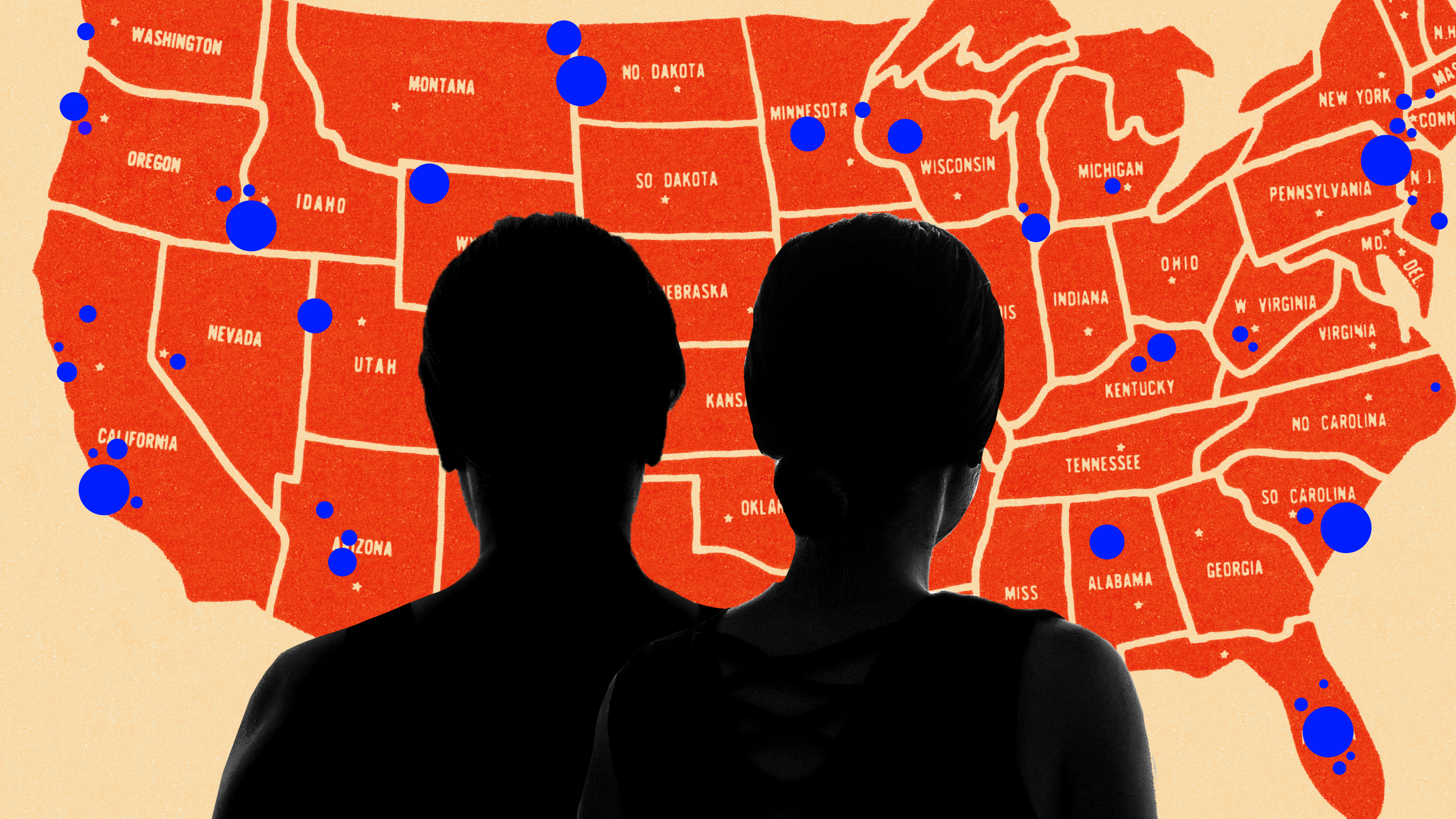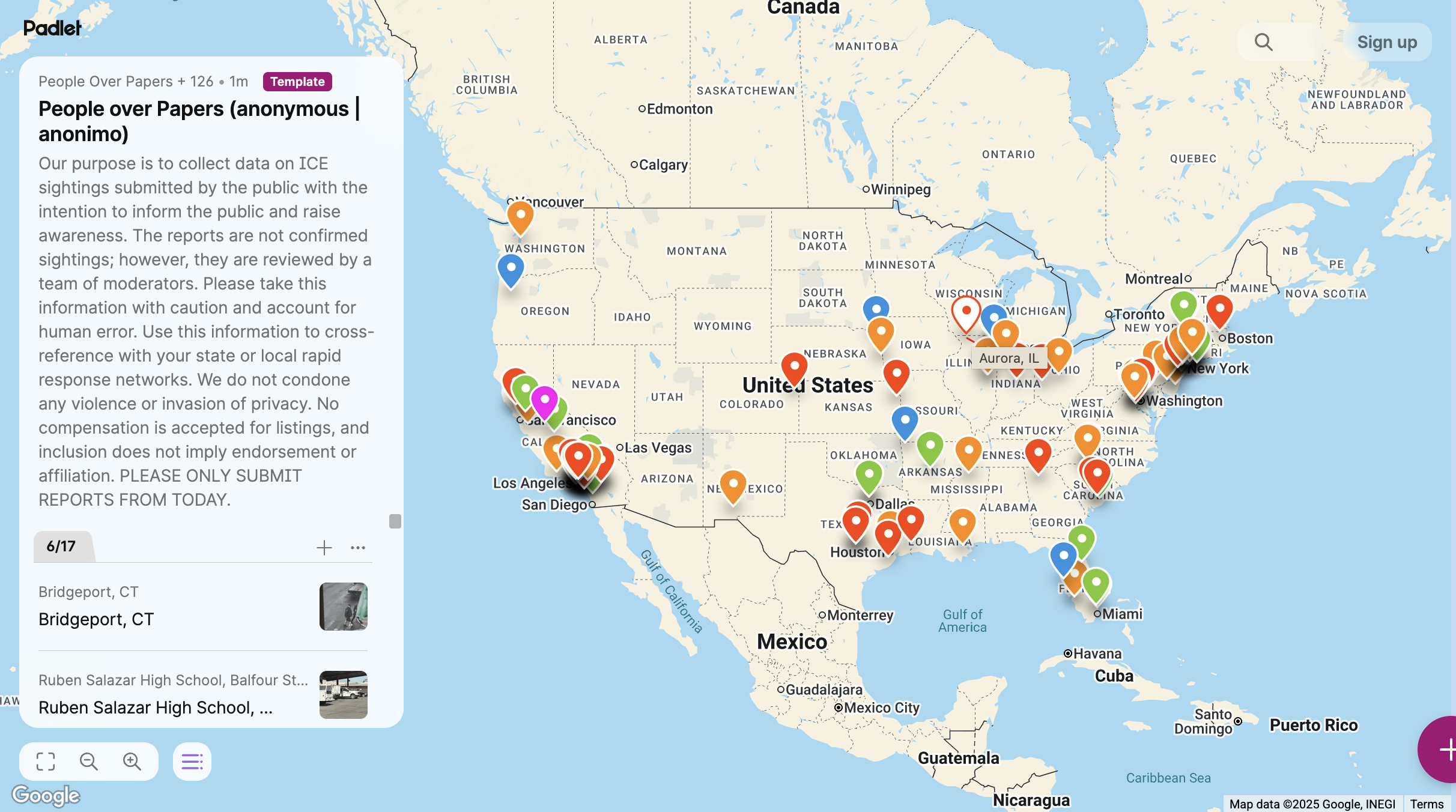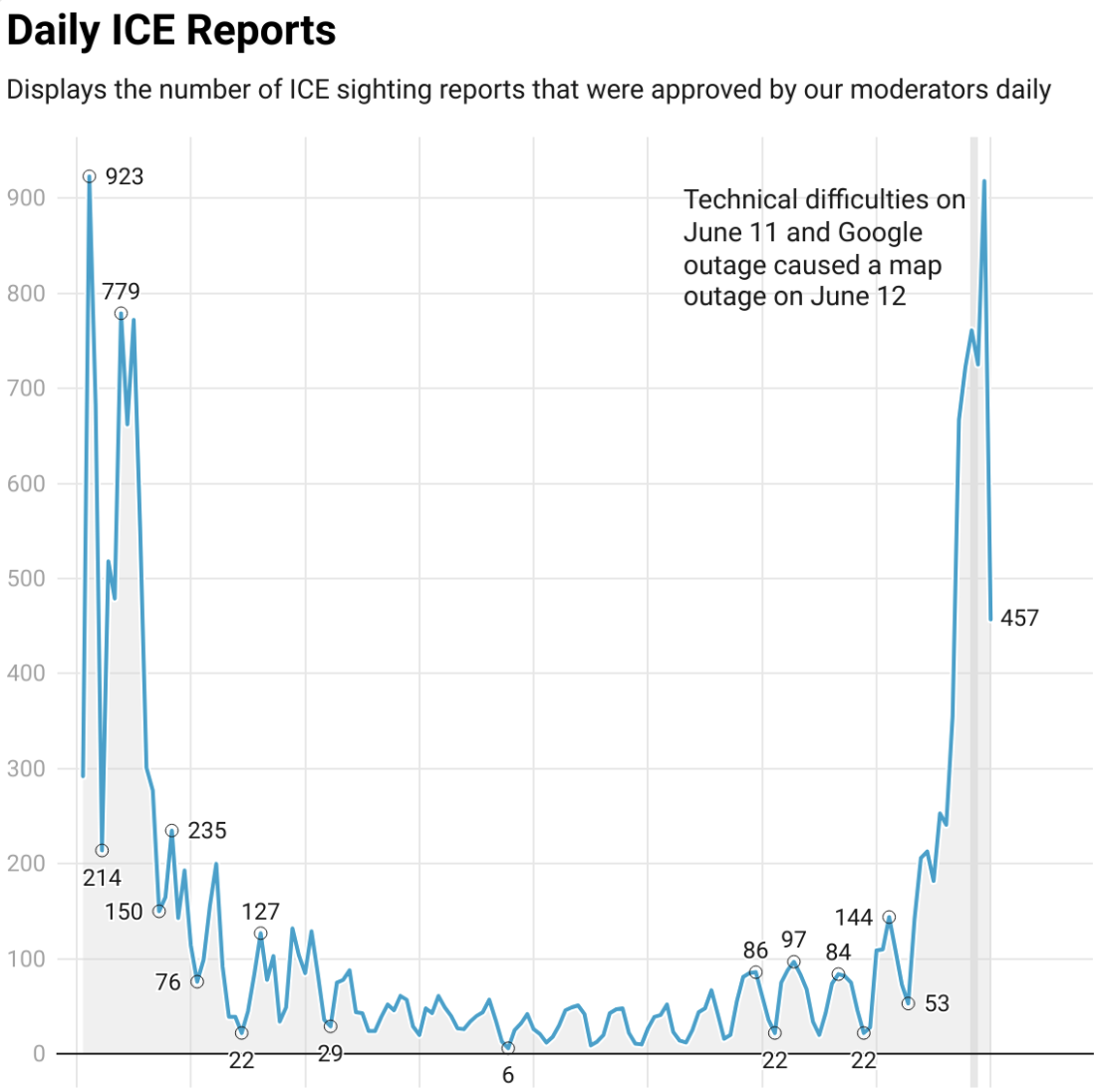How Two Women Turned a TikTok Post Into a Nationwide ICE Raid Tracker
A real-time map has become a lifeline for communities across the country—and drawn the government’s eye.


Update—October 6, 2025: Since this story was first published, the founders of People Over Papers have relaunched their ICE-raid tracker at https://iceout.org/en. Their original Padlet-hosted map was taken offline following public pressure from right-wing influencer Laura Loomer.
It all started with a screenshot on Inauguration Day.
Celeste, a 30-year-old California-based digital creator and second-generation Mexican immigrant, was scrolling TikTok when she saw a post listing locations where people had spotted ICE agents. “I thought, there's got to be a better way to do this,” she recalls. “Or at the very least, visualize it—pick up on patterns or anything like that.” She decided to start a Google form where people could submit ICE sightings. She manually reviewed each submission and plotted it on Google Maps. Within hours of posting the link on social media, the map was gaining traction.
Just a few days later, on the other side of the country, Kat, a Latina educator and mother of four, was stuck at home on a snow day when she stumbled across Celeste’s account.
“Everything had started unraveling with the targeting of immigrant communities,” says Kat, 43. “I was so overwhelmed with all the information and felt like I needed to do something. So I reached out to her immediately. And I was like, ‘Look, I don't know what I can do, but I'm a quick learner. I'm pretty good with Excel and things like that. Whatever I can do, I want to help.’”
The manual mapping system Celeste had set up was cumbersome, so when Kat connected with her, she suggested they move everything over to the website Padlet. The virtual bulletin board-style platform, which Kat had used in her work as an educator, made it easier to organize submissions and update the map in real time. It gave the project a more stable home, and a way to quickly scale up their operation.
That collaboration marked the beginning of People Over Papers, a digital tool that is now one of the most widely used civilian resources for tracking ICE activity in the country. Six months in, it has logged more than 37 million views and nine million unique visitors. What started as a grassroots experiment has grown into a full-fledged operation, with more than 40 volunteers working across time zones to verify and map community-submitted ICE reports in real time. And all of it has been built independently, without outside funding or formal institutional support.
Get exclusive access to fashion and beauty trends, hot-off-the-press celebrity news, and more.

The People Over Papers map.
Demand for the map has surged in recent weeks, for obvious reasons. ICE has been carrying out sweeping workplace raids in cities like L.A., Chicago, and Newark, targeting industries from agriculture to hospitality and arresting hundreds. After protests erupted in L.A., the Trump administration responded by federalizing the California National Guard and deploying Marines, the first such move since 1965. Although the agency briefly paused non-criminal enforcement in some sectors following backlash, Homeland Security Secretary Kristi Noem made clear the campaign was far from over. “This is only going to continue until we have peace on the streets of Los Angeles,” she said at a news conference last week.
These escalations have only reinforced what Celeste had sensed from the beginning: people weren’t just scared, they were desperate for real-time information. “The truth of the matter is I didn't plan this at all. I wasn't strategic about it,” Celeste says. “The idea was to inform people. And the most popular form of information is: Where is ICE right now?”
Now, the team asks people submitting reports to include details based on the SALUTE method—Size, Activity, Location, Unit, Time, and Equipment—which helps volunteers verify the information before adding it to the live map. Volunteers, most of whom found the project through TikTok or Instagram, help verify submissions against photos, timestamps, and on-the-ground observations. Unreliable reports get filtered out, confirmed sightings are marked as such, and submissions that are strong but not definitive are labeled accordingly.
A recent post from Dallas, for example, described officials in green uniforms conducting an “operativo” near a wholesale market, with photos attached and the time logged as 7:40 a.m.—enough to meet the threshold for a probable ICE sighting, even if not yet fully confirmed.
Submissions have skyrocketed since launch—from around 50 early on, to 30 to 50 per day in March and April, to more than 1,000 in the past week alone. According to Kat, they post about 85 to 90 percent of what’s submitted.
I have family members and friends who are undocumented...The only thing that makes their life harder than mine is that they don't have documents.
Celeste, People Over Papers cofounder
Celeste estimates she works at least six hours a day on the project while juggling her full-time job in IT. She’s also maintained a steady presence on TikTok, where her following has grown to more than 50,000 as she continues sharing immigration updates and project news. Kat, by contrast, keeps a lower profile online and is more private about her involvement. While Celeste focuses on day-to-day operations and managing the map in real time, Kat has taken the lead on the organizational backbone, from handling logistics and tech issues to managing their business plans.
Their workload is dizzying: “I’ve had to disconnect for a little bit because I do have a full-time job, I have children, so I had to find a balance for my own mental health,” Kat says. “I always remind Celeste to take a break. You can’t pour from an empty cup.”
But for Celeste, stepping back isn’t easy. Her commitment to the work is deeply personal. “I have family members and friends who are undocumented, friends that grew up in the same exact situation as me—same school, same town, same everything. And the only thing that makes their life harder than mine is that they don't have documents,” she says.
That divide became painfully real earlier this month, she says, when her brother was on his way to work one morning. He had stopped to pick up a coworker when an unmarked truck cut them off and three more surrounded their car. According to Celeste, ICE agents stepped out and detained his coworker on the spot. “It, unfortunately, is getting closer and closer to home,” she says.

People over Papers submission metrics, through June 1.
The headlines that followed only intensified that feeling. Last week, a WIRED report revealed that Army intelligence analysts had flagged tools like People Over Papers as potential national security threats.
To Kat and Celeste, the government’s response only underscored why the tool was needed. “We have a First Amendment right to have a tool like this,” Celeste says. “It’s raising awareness and gives a stark visual of what is happening right now.”
Their work continues, but they have added new precautions: contributors now sign NDAs, and the team is working on a more formal vetting rubric to ensure consistency.
Still, loved ones of both women have expressed concerns about their safety. “To be honest, I think I was very hesitant and wary. Out of everybody in my family, I was the most cautious,” says Kat’s 20-year-old daughter, Alexandra, who is training to volunteer with People Over Papers. She explains that she offered hands-on support in the early days of the project, including by helping her mom set up a VPN for security purposes. “I feel a roller coaster of emotions—of being scared and then proud. I’m seeing friends of mine posting [the map] on social media, and nobody knows it’s her.”
Though they’ve never met in person, Kat and Celeste have built a bond that’s carried them through the ups and downs of this journey. They joke on video calls, tease each other about music tastes (Celeste’s obsession with Bad Bunny is a recurring bit), and check in constantly. “She’s very Type A,” Kat says. “I’m totally not. But I think we complement each other really well.”
“She’ll remind me to touch grass,” Kat laughs. “I’ll remind her to take a break.” In the process of building a lifeline for others, they’ve built one for each other, too.
They had what it took. And what it took was ‘ganas’—a Spanish word for grit, resilience, and the deep conviction to get it done.
Noemi Jimenez of the immigrant advocacy group Vecinos Unidos DFW
Despite the looming fear of government surveillance, the emotional toll, and the constant pressure from loved ones to stay safe, Kat and Celeste have kept going. To people like Noemi Jimenez, that determination says everything.
A founding steward of the grassroots immigrant advocacy group Vecinos Unidos DFW, Jimenez first connected with Celeste online and later became a moderator for People Over Papers. She now helps spread the word on the ground in Texas.
To her, the map’s popularity reflects a broader crisis of trust. “People do not trust the activity of ICE,” she says. “Or even worse—we are certain that they are not doing things lawfully.”
Jimenez, who teaches Know Your Rights block walks and does courthouse observation, says she knew from the start that this project had likely been created by women—because of how intentionally it prioritized safety, accuracy, and community. “They had what it took,” she says. “And what it took was ganas”—a Spanish word for grit, resilience, and the deep conviction to get it done.
That conviction is now propelling the founders into their next chapter. They’ve applied for nonprofit status and hope to expand the project’s capabilities: to add trusted referrals for immigration attorneys, protest safety info, and more searchable archives. “We just want to provide a safe space for historically marginalized communities,” Kat says.
Their hope is to one day make the project sustainable enough that they can work on it full-time. “We want to keep this women-based and Latina-owned,” she later adds. “We're all college educated, and it's so empowering. I want that to be the legacy too.”
Editor’s note: Kat and Celeste are being identified by first name only due to safety concerns. Alexandra is a middle name.

Noor Ibrahim is the deputy editor at Marie Claire, where she commissions, edits, and writes features across politics, career, and money in all their modern forms. She’s always on the hunt for bold, unexpected stories about the power structures that shape women’s lives—and the audacious ways they push back. Previously, Noor was the managing editor at The Daily Beast, where she helped steer the newsroom’s signature mix of scoops, features, and breaking news. Her reporting has appeared in The Guardian, TIME, and Foreign Policy, among other outlets. She holds a master’s degree from Columbia Journalism School.